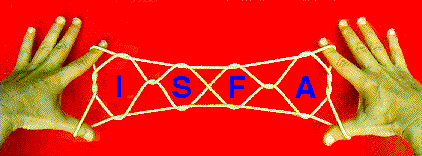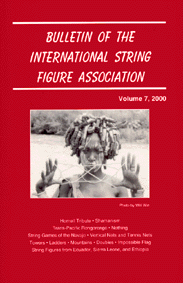Volume 7 (2000): 366 pages - Table des Matières
Edité par - Mark A. Sherman, Pasadena, California
Rédacteurs Associés - Joseph D'Antoni, Queens, New York; Myriam Namolaru, Haifa, Israel;
Belinda Holbrook, Davenport, Iowa; Stephan Claassen, Best, Netherlands.
Comité de Rédaction - Hiroshi Noguchi, Tokyo, Japan; Philip Noble, Inverness, Ecosse
Le Bulletin de l'Association Internationale du Jeu de Ficelle (BISFA) est une publication savante
présentant des documents originaux qui fait progresser notre compréhension et renforce
notre plaisir des jeux de ficelle. BISFA est publié annuellement, en septembre, par ISFA Press
(Pasadena, Californie). BISFA remplace le Bulletin de l'Association des Jeux de Ficelle,
(Toky Nippon Ayatori Kyokai), qui a été publiée en 19 volumes (1978-1993).
Les traductions proposées ne comprennent pas les illustrations et photos du texte original.
J'ai traduit ces textes pour vous donner un aperçu de la qualité et de la richesse de
ces publications.
Tribute
- A Tribute to James Hornell (1865-1949), by David Heppell, Gibsons, British Columbia, and Mark Sherman, Pasadena, California (pages 1-56) - When James Hornell died in 1949 obituaries appeared in several newspapers and nearly a dozen scientific journals, each devoted to a different subject (natural history, marine zoology, Polynesian studies, anthropology, and seamanship). As a young man Hornell was a marine zoologist, but later became a fisheries expert, folklorist, and ethnographer. In his post-retirement years he was widely acknowledged as the world's foremost authority on primitive watercraft: his three-volume monograph "Canoes of Oceania" (Bishop Museum, 1936-38), coauthored with A.C. Haddon, remains a classic to this day. But James Hornell also collected string figures — hence the tribute here. Thanks to Hornell's keen abilities we now enjoy collections from Africa (Sierra Leone, Liberia, Madagascar, the Sudan), Asia (India, Sri Lanka, and Burma), and the Pacific Islands (Fiji, Tonga, Samoa, and Tahiti among others). Who was Hornell? What were his special skills, and how did these skills uniquely qualify him to record string figures and tricks? What were the circumstances that led to such extensive travel? What is significant about his published works on string figures? These are the sorts of questions that will be addressed in this tribute. (un extrait ici )
Commentary
- String Figures and Shamanism, by Lois Stokes, Kauai, Hawaii, photographs by Earl Stokes (pages 57-65) - Are string figures just a child's game? In this article, Lois Stokes asks you to consider the idea that "the world is what you think it is." Perhaps string figures are more, much more than child's play.
Research Reports
- An Easter Island String Figure and Rongorongo Records Demonstrate Trans-Pacific Contact, by Sergei V. Rjabchikov, Krasnodar, Russia, (pages 66-70) - Most scholars believe that Easter Islanders are Polynesians, having arrived from the west. Yet some plants, including the South American sweet potato, clearly arrived from the East. In this article the author presents data suggesting that certain rongorongo glyphs, when translated into Rapanui, are words mentioned in a chant that accompanies a traditional Easter Island string figure. Furthermore, some of these words are borrowed from the language spoken by Quechua Indians of Peru, thus supporting the theory that trans-Pacific contact occurred prior to European discovery of the island. Several other lexical parallels between Quechua and Polynesian languages are examined.
- Rien: Une Série de Jeux de Ficelle que M'a Enseignée Elsie Sperry , par Audrey Collinson Small, Paradise, Californie, (pages 71-84) - Les jeux de ficelle réalisés autrefois par les immigrants américains arrivant d'Angleterre et d'Europe au début du 19ème siècle. Dans cet article l'auteur décrit une série de jeux de ficelle qui semble dater de cette période. Le plus intéressant est le fait que la série soit réversible. L'auteur explore la signification culturelle des noms attribués à chaque motif.
- Some String Figures and Tricks of the Quichua Indians of Ecuador, by Dominique Irvine and Alex Johnston Abraham, East Sussex, England, (pages 85-93) - Little is known about the string figures and tricks once made by the Indians of Ecuador. In this report the authors present four string figures and four string tricks gathered in 1984 among the Quichua Indians of Provincia Napo. Of particular interest is a two-diamond figure made upon the feet.
- Some String Figures and Tricks from Sierra Leone and the Gold Coast, by Carey C. K. Smith, Stratford, New Zealand,(pages 94-100) - When James Hornell visited Sierra Leone in 1928 he recorded several dozen string figures from natives of several different tribes. He also observed many string tricks, but these did not appear in his published report. In this article, the author describes three string figures and one trick which he gathered in Sierra Leone fifteen years after Hornell's visit. In each case, the names and methods associated with each figure are nearly identical to those reported by Hornell, thus underscoring the fact that string figures are often stable elements of material culture. A string trick from the Gold Coast (Ghana) is also described.
- String Figures from Southwestern Ethiopia, by Will Wirt, Port Angeles, Washington, (pages 101-118) - String figures are a popular form of recreation in southwestern Ethiopia. This article describes figures collected there from Karo, Mursi, and Ari tribal members and from nontribal sources.
- String Games of the Navajo, by Will Wirt, Port Angeles, Washington and Mark Sherman, Pasadena, California; Cultural notes contributed by Mike Mitchell, Rough Rock, Arizona, (pages 119-214) - In this article the authors describe seventy-four string figures and tricks known to the Navajo Indians of Arizona. Methods for making sixty of these were gathered during the winter of 1999-2000 on a series of visits to the Navajo reservation. Thirty-four of these are new additions to the published literature on Navajo string games. Remarkably, methods for twenty of the twenty-seven Navajo string figures gathered by Caroline Furness Jayne nearly a century ago were still remembered, suggesting that string games are a stable element of Navajo material culture. The significance of string games among the Navajo is examined in an appendix to this article.
- Usage de Jeux de Ficelle pour l'Enseignement de l'adresse Mathématique — Partie 4: Filets Verticaux et Filets de Tennis, par James R. Murphy (inoli), Whitestone, New York, (pages 215-287) - Aujourd'hui les jeux de ficelle sont souvent perçus comme des reliques sans valeur des sociétés de la pré-écriture. Peu de spécialistes apprécient le rôle qu'ils ont autrefois joué dans le développement de pensée analytique . Dans cet article l'auteur présente les deux derniers "systèmes" du jeu de ficelle, qu'il emploie pour enseigner l'adresse mathématique à des étudiants réticents. Dans le système 'Filet Vertical', la complexité est générée par la répétition des tissages de nombreuses boucles empilées sur 2 . Dans le système 'Filet de Tennis' les boucles sont "tressées" l pour générer des motifs richement ornés qui rivalisent avec les figures maillées classiques des Iliens du Pacifique. Une A "notation en cercle" pour enregistrer les mouvements complexes est aussi présentée.
- Les Tours d'Hanoï: Combiner les Côtes et les Nuages Orageux , par Frank J. Oteri, New York, New York (pages 287-295) - Au début des années 1900 Caroline Furness Jayne a noté les méthodes pour réaliser deux jeux de ficelle navaho extrêmement uniques. 'Nuages Orageux' est un excellent exemple d'un jeu de ficelle dont la séquence de tissage peut être "répétée" à l'infini pour ajouter de nouvelles unités de nouveaux motifs au motif final . 'Sternum et Côtes' est une figure remarquablement réalistique qui commence avec quatre boucles empilés sur les index. Dans cet article l' auteur montre comment une séquence de tissage répété de 'Nuages Orageux' peut être empruntée et appliquée à 'Sternum et Côtes.'Le résultat est un motif qui représente une série d'alignement de pyramides ou"pagodes." Ce motif ressemble à un célèbre puzzle mathématique appelé la 'Tour d'Hanoï.'
- Doubly-Framed Ladder String Figures with Mixed Junctions, by Kazuo Kamiya, Saitama, Japan,(pages 296-309) - In this article the author presents a highly innovative technique for making doubly-framed ladder (diamond) string figures with different types of string intersections between each diamond. Three types of intersections or junctions are defined: no interlock (a simple crossing); single interlock; and double interlock. The author shows how multi-step ladders with a limited number of different junction combinations can be assembled by simply combining the appropriate weaving units.
- Mountain String Figures, by Kazuo Kamiya, Saitama, Japan, (pages 310-315) - 'The Mountains' is a traditional Alaskan Inuit string figure featuring four peaks. In this article the author describes a way to make any number of mountain peaks. Both one- and two-loop versions are described.
- Jeux de Ficelle Double Navajo, par Kazuo Kamiya, Saitama, Japan, (pages 316-327) - Lorsqu'on a deux bouclestwo loops sur le même doigt, la commande jeu de ficelle 'Navaho' veut dire:
"faire passer la boucle inférieure par-dessus la boucle supérieure et la libérer." Ce mouvement est ainsi nommé car il est fréquemment employé par les Indiens Navajode l'Amérique du sud-ouest, lorsqu'ils réalisent des jeux de ficelle. Le terme 'Double Navajo' est plutôt nouveau. Il signifie "faire passer la boucle inférieure en position supérieure, puis de navajo les deux boucles." Dans cet article l'auteur montre comment cette technique peut être employée pour créer beaucoup de motifs amusants. L'article se termine avec une série de jeux de ficelle qui illustre la fable bien connue "La Tortue et le Lièvre." - Double Caribou String Figures, by Kazuo Kamiya, Saitama, Japan, (pages 328-335) - The Inuit are fond of making single and double versions of various animal string figures. For example, in Jenness's monograph on Alaskan string figures methods for making 'One Mammoth' and 'Two Mammoths' are given (Jenness 1924:43B, 44B). But a double version of 'Caribou' is lacking. In this article the author presents two methods for making 'Two Caribou'. Eleven variations representing various animals are also described.
- Un Nombre, Quelques Lettres, et le Logo de Mercedes Benz: Cinq jeux de ficelle amusants , par Kazuo Kamiya, Saitama, Japan, (pages 336-338) - Les cinq jeux de ficelle décrits dans ce court article, sont étendus en employant une méthode d'extension novatrice qui facilite la présentation de lignes courbes.
- Some Simple String Polyhedra, by Tetsuo Sato, Kumamoto, Japan, (pages 339-342) - Cube, tetrahedron, and octahedron are three-dimensional shapes familiar to anyone who studies science or math. Their symmetries are pleasing to the eye. In this article the author describes how to make these three shapes using a loop of string. The figures are easily adapted for large scale presentation to an audience.
- Olympic Flag: An Impossible String Figure, by Tetsuo Sato, Kumamoto, Japan, (pages 343-345) - In this article the author presents 'Olympic Flag' — a rectangular string figure that features five linked rings. Although novel, this string figure is actually a complex knot. Yet its method of manufacture is remarkably simple.
Book and Video Reviews - by Belinda Holbrook, Will Wirt, and Mark Sherman (pages 346-352)
- Lost! A Story in String, by Paul Fleischman.
- Pull the Other One! String Games and Stories, by Michael Taylor.
- By Hook or by Book, by D. R. Meredith.
- Lustige Fadenspiele: Fingerspiele fr alle, by Anne Akers Johnson.
- Das Hexenspiel: Finger-Fadenspiele neu entdeckt, by J. Ellfers and M. Schuyt.
- Fadenspiele: Zaubereien mit der Schur, by Camilla Gryski.
- Die schצnsten Fadenspiele, by Camilla Gryski.
- Die schצnsten Fadenspiele aus aller Welt! by Gnter Frorath.
- Alte und Neue Fadenspiele fr hurtige Finger , by Lena Wellnhofer.
- String Figure Bibliography, 3rd Edition, by the International String Figure Association (edited by Tom Storer).
Letters to the Editor (pages 353-356)
- The Real Origin of Cat's Cradle, Part 2 - Philip Noble. The author continues to argue that the term "Cat's Cradle" refers to a crib once popular in Scotland. The crib had six brass knobs on its frame. String was wound around the knobs to form a web that kept the baby safe from cats jumping in on it. A photo is offered as evidence.
- Regarding "The Real Origin of Cat's Cradle" - A. Johnston Abraham. The author argues that the term "Cat's Cradle" is a nautical term referring to a net made of rope for "catting" (storing) a ship's anchor.
- Angel, Diamond, and X - Pat Whale. Three simple variations of figures appearing in Jayne's book are offered.
- La maison de Saint Nicolas- Axel Reichert. Un jeu de ficelle qui ressemble au jeu populaire nécessitant un crayon et un papier est décrit.
Nomenclature (pages 357-365)
- Abréviations et termes utilisés dans le Bulletin sont récapitulés et illustrés. Illustrations pas-à-pas pour réaliser deux jeux de ficelle ( Etoiles Binaires et Boomerangs ) sont donnés en exemple.
Erratum (page 366)
- A mistake in Bulletin 6 is noted.
Ajouter un commentaire



